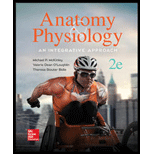
_____ 1. All of following are functions of the kidney except
- a. gluconeogenesis, the formation of glucose from non-carbohydrate sources.
- b. release of erythropoietin to control erythrocyte production.
- c. control of blood pressure through the release of renin.
- d. production of plasma proteins to control blood volume.
Introduction:
Kidney balances the water and salt concentration in the body by removal of waste products from the blood. It maintains normal blood pressure by balancing the electrolytes such as sodium and potassium. It produces red blood cells and during starvation, performs gluconeogenesis.
Answer to Problem 1DYKB
Correct answer:
Production of plasma protein to control blood volume is a function of the liver. Therefore, option d. is correct.
Explanation of Solution
Reason for the correct statement:
Option d. is given as “production of plasma proteins to control blood volume”. Protein present in blood such as albumin, fibrinogen, and globulin are produced in reticuloendothelial cells of the liver. Hence, the liver produces plasma protein which controls the blood volume.
Hence, option d. is correct.
Reasons for incorrect statements:
Option a. is given as “gluconeogenesis, the formation of glucose from non-carbohydrates source”. Gluconeogenesis occurs in the liver and kidney cortex. Hence, option a. is incorrect.
Option b. is given as “release of erythropoietin to control erythrocytes production”. Erythropoietin hormone is released by endothelial cells of peritubular capillaries present in renal cortex of the kidney. Hence, option b. is incorrect.
Option c. is given as “control of blood pressure through the release of renin”. Angiotensin-II hormone is responsible for increasing blood pressure and is produced in response to release of renin from the kidney. Hence, option c. is incorrect.
Hence, options a., b., and c. are incorrect.
Production of plasma protein of blood takes place in the liver.
Want to see more full solutions like this?
Chapter 24 Solutions
Anatomy & Physiology: An Integrative Approach
- Identify the indicated cavity (Fucus). a. antheridia b. conceptacel c. receptacle d. oogonium e. none of thesearrow_forwardIdentify the indicated structure (Saprolegnia). a. antheridium O b. oospore c.sperm d. auxospore e. tetraspore Of. zygosporearrow_forwardUsing information from the primary literature (several references have been provided as a starting point below) please answer the following question: Based on your review of the literature on rewilding, what are the major scientific pros and cons for rewilding? Please note that the focus of this assignment are the (biological) scientific issues associated with rewilding. As will be discussed in class, there are a number of non-scientific issues involved or implicated in rewilding, all ultimately affecting the public acceptability of rewilding. Although these issues are important – indeed, critical – in this assignment you should focus on the biological science issues and questions. Details: You must enumerate at least two pros and at least two cons. Your answer should be no more than 500 well-chosen words, excluding references. Think carefully about how best to organize and structure your answer. Aim for high information density: say a lot, but say it succinctly. Recall Nietzche’s…arrow_forward
- Using information from the primary literature (several references have been provided as a starting point below) please answer the following question: Based on your review of the literature on rewilding, what are the major scientific pros and cons for rewilding? Please note that the focus of this assignment are the (biological) scientific issues associated with rewilding. As will be discussed in class, there are a number of non-scientific issues involved or implicated in rewilding, all ultimately affecting the public acceptability of rewilding. Although these issues are important – indeed, critical – in this assignment you should focus on the biological science issues and questions. Details: You must enumerate at least two pros and at least two cons. Your answer should be no more than 500 well-chosen words, excluding references. Think carefully about how best to organize and structure your answer. Aim for high information density: say a lot, but say it succinctly. Recall Nietzche’s…arrow_forwardNow draw a rough sketch of what the control data might look like if in addition to the specific binding, there was also a considerable amount of nonspecific binding (again using a normal dose/response curve) (do % total bound ligand vs concentration)arrow_forwardWhat are functions of cuboidal cells in the kidney? Select all that apply. Concentration of gases Dilution of chemicals Secretion of molecules Nutrition to tissues Support of tissues Absorption of moleculesarrow_forward
- question1 In plants, epithelial tissue is only found as the outermost cell layer and acts as a barrier. In humans, epithelial tissue is found inside the body as well as on the surface. What function(s) does/do epithelial tissue carry out in humans? Select all that apply. Waste storage Filtration Oxygen transport Protection Diffusion Osmosis Absorptionarrow_forwardWhat words best describes this organism? a. Unicellular/nonmotile Ob. unicellular/motile c. colonial/nonmotile d. colonial/motile e. multicelluar O f. siphonous g. none of thesearrow_forwardIdentify the phylum or class. a. Euglenophyta b. Dinoflagellata c. Bacillariophyceae d. Oomycetes e. Phaeophyceae O f. Myxomycota g. Xanthophyceae ○ h. Chrysophyceae i. Dictyosteliomycota O j. Rhodophyta Ok. Chlorophyceaens I. Charophyceaensarrow_forward
- What is produced inside the indicated structure (Fucus). a. eggs O b. antheridia ○ c. sperm d. zygotes e. none of thesearrow_forwardGreen Algae, as a group, is actually paraphyletic with one subgroup more closely related to higher plants than the other. Which of the following green algae groups is more closely related to higher plants: a. Charophyceans b. Chlorophyceans c. Rhodophyta d. Xanthophyceansarrow_forwardA single-celled green algal genus that is motile with 2 flagella, has a cup shaped chloroplast, and an eyespot: a. Volvox b. Chlamydomonas c. Euglena d. Codiumarrow_forward
 Biology (MindTap Course List)BiologyISBN:9781337392938Author:Eldra Solomon, Charles Martin, Diana W. Martin, Linda R. BergPublisher:Cengage Learning
Biology (MindTap Course List)BiologyISBN:9781337392938Author:Eldra Solomon, Charles Martin, Diana W. Martin, Linda R. BergPublisher:Cengage Learning
- Essentials of Pharmacology for Health ProfessionsNursingISBN:9781305441620Author:WOODROWPublisher:Cengage





